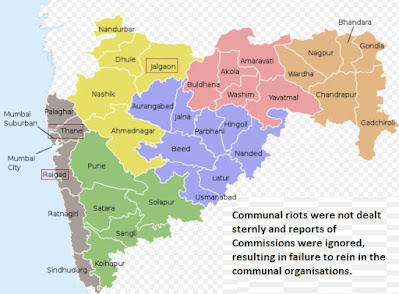Shams Ur Rehman Alavi
As lynching incidents and hate crimes continue, we talk about the failure of institutions, particularly, the inability of police and agencies in promptly dealing with violence.
Also, we talk about how police often fail to act on mob and often the victim gets harassed or framed due to the street power of the goons and their political associations.
But we have reached the state not in a few months or years. It has been a weakening of institutions over decades. Decades ago, when riots occurred, it often happened that the officials didn't act promptly and excesses or biased action took place.
Imagine, just a year after the horrific Ahmedabad riots of 1969, there were communal riots in Jalgaon, Bhiwandi and Mahad in Maharashtra. Over 120 persons were killed in the riots in these three places and property was destroyed.
The riots had again drawn attention of the nation. Muslims suffered heavily, in terms of loss of lives too. After the riots, justice DP Madon was given task for judicial probe in Jalgaon. Running into six volumes it was a very clear report.
The role of police had come up in debates. In Jalgaon, out of 43 persons killed, 42 were Muslim. One of the most heart-rending incidents was the killing of Hajra Begam's children in front of her eyes. This had prompted Nida Fazli to wrote the famous verse.
But, as usual, communal riots were seen as a regular feature in those days. After a few days, news would not be on front page and then focus was lost. The Madon Commission report was voluminous, it had brought out everything in open.
There was documented evidence, commission report told everything. Evil should have been nipped in the bud. Government should have acted. The names of organisations, their role, their entire planning and all other information was there in the report.
In Lok Sabha, Mohd Ismail had tabled adjournment motion. Speaker said that he was not sure that the motion could be allowed as it was state subject. The point is that if governments were serious, they could have taken banned the outfits that were involved in large-scale rioting and killings, then only.
But this didn't happen. The will was missing, there was no intent. If government acts tough, there is fear among the lawbreakers and rioters. These organisations continued to function and there was no serious action. Neither the special acts or tough laws were invoked, nor there were steps taken to stop these organisations from expanding.
As a result, they were emboldened and within a decade--by 1980s they were able to mobilize so many people that violence spread across India during Rath Yatra. So today when talk about how institutions collapsed, it's not that suddenly in the last five or ten years this has happened.
Two decades later, the deadly Mumbai riots too witnessed the same pattern. The Justice Sri Krishna Commission report kept gathering dust for years and its recommendations were not acted upon. Role of Congress was perplexing and the major changes that were needed in administration, forces, composition of police and implementation of laws, couldn't take place.
Successive governments played a role and the decades of softness towards fundamentalist and radical groups, made them so powerful that it became almost impossible to stop them in later years. Photo is just for representational purpose. Courtesy.



























